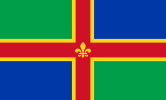Related Research Articles

The Benedictines, officially the Order of Saint Benedict, are a monastic religious order of the Catholic Church following the Rule of Saint Benedict. They are also sometimes called the Black Monks, in reference to the colour of their religious habits. They were founded by Saint Benedict of Nursia, a 6th-century monk who laid the foundations of Benedictine monasticism through the formulation of his Rule of Saint Benedict.
Luffield Abbey is a place in the very north of Buckinghamshire, England. It is on the border with Northamptonshire, close to Biddlesden and Silverstone.

Freiston is a village and civil parish in Lincolnshire, England. The population of the civil parish at the 2011 census was 1,306. It is situated approximately 2 miles (3 km) east from Boston. The Greenwich Prime Zero meridian line passes between the village and Hobhole Drain.
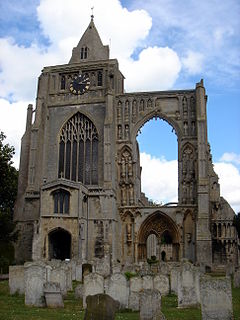
Crowland Abbey is a Church of England parish church, formerly part of a Benedictine abbey church, in Crowland in the English county of Lincolnshire. It is a Grade I listed building.

Thorney Abbey, now the Church of St Mary and St Botolph, was a medieval monastic house established on the island of Thorney in The Fens of Cambridgeshire, England.

Isleham Priory Church located in Isleham, Cambridgeshire is a Norman church, built in ca 1090. Despite being converted into a barn, it remains in a largely unaltered state.
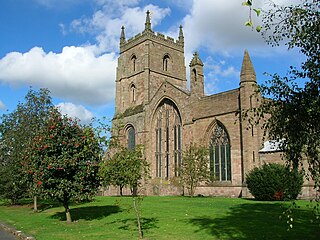
The Priory Church is an Anglican parish church in Leominster, Herefordshire, England, dedicated to Saint Peter and Saint Paul. The building was constructed for a Benedictine Priory in about the 13th century, although there had been an Anglo-Saxon monastery in Leominster, possibly on the same site. In 1539 the east end of the church was destroyed along with most of the monastic buildings, but the main body of the church was preserved.

Snelshall Priory was a Benedictine priory in Milton Keynes, Buckinghamshire in the United Kingdom, built around 1200. The priory was founded after Sybil d'Aungerville granted land at Tattenhoe to Lavendon Abbey, a Premonstratensian monastery of 'White canons' who most likely started a cell at Snelshall. This did not thrive and was abandoned about 1207. About 1219, the founder's son brought in Benedictine monks, increased the endowment and the new monastery began again. However Snelshall Priory paid 1 mark a year to Lavendon until 1232, at which point the Bishop of Lincoln decided that Snelshall owned its own lands and chapel. The priory accumulated various land through gifts, but even with all these grants, in 1321 when Henry Burghersh visited, it was so poor that "the monks scarcely had the necessities of life and had to beg even for these".
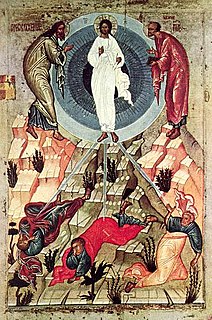
Nicholas Love, also known as Nicholas Luff, was first a Benedictine and then a Carthusian monk in medieval England, and became the first prior of Mount Grace charterhouse in Yorkshire. He was the translator and reviser of a popular devotional treatise which was used by the Church authorities to counter the teaching of John Wycliffe. In his later years he convinced Henry V of England King Henry V to attempt to reform Benedictine monasticism in England, but died before measures could be taken.
Bedford Abbey was a short-lived Benedictine monastery, recorded in 10th century England. Bedford Priory, perhaps representing the same institution two centuries later, was an Augustinian priory that within two decades of its foundation moved to nearby Newnham.
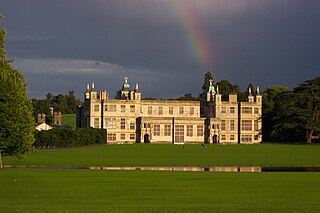
Walden Abbey was a Benedictine monastery in Saffron Walden, Essex, England founded by Geoffrey de Mandeville, 1st Earl of Essex between 1136 and 1143. Originally a priory, it was elevated to the status of an abbey in 1190.
Boston Priory was a priory in Boston, Lincolnshire, England.
Covenham Priory was a priory in Covenham St Bartholomew, Lincolnshire, England.

Deeping St James Priory was a priory in Deeping St James, Lincolnshire, England. In 1139 Baldwin Fitz Gilbert established the Benedictine Priory of Saint James at Deeping as a cell of Thorney Abbey. The cell was dissolved at the surrender of Thorney in 1539. The priory church remains as the Church of England parish church of Deeping St James and is a Grade I listed building.
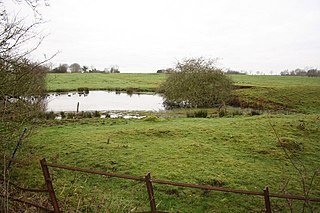
Minting Priory was a priory in Minting, Lincolnshire, England.
Skendleby Priory was a priory in the village of Skendleby, Lincolnshire, England.
Eye Priory was a Benedictine Priory dedicated to St Peter in the town of Eye in the UK county of Suffolk. It was founded by Robert Malet c. 1080 and originally an Alien Priory dependent on the Abbey of Bernay in Normandy. It became independent in 1385 by charter of Richard II when it could support only 3 -4 monks. It was finally dissolved in 1537 as part of the dissolution of the monasteries with the lands being given to Charles Brandon.

Rumburgh Priory was a Benedictine priory located in the village of Rumburgh in the English county of Suffolk. The priory was founded in about 1065 as a cell of St Benet's Abbey at Hulme in Norfolk. At the time of the Domesday survey it had 12 monks. The ownership of the priory was transferred to St Mary's Abbey in York towards the end of the 12th century. The monks of Rumburgh were particularly devoted to St. Bee, whom they commemorated at Michaelmas.
Snape Priory was a priory in Suffolk, England. It was founded as a cell of the Benedictine St John's Abbey, Colchester in Essex.
References
- ↑ Historic England. "Freiston Priory (353896)". PastScape. Retrieved 3 August 2011.
- ↑ "The priory of Freiston". Houses of Benedictine Monks. Victoria County History. Retrieved 3 August 2011.
Coordinates: 52°58′26″N0°03′02″E / 52.9739°N 0.0506°E
| This article about a Lincolnshire building or structure is a stub. You can help Wikipedia by expanding it. |
| | This article about a British Christian monastery, abbey, priory or other religious house is a stub. You can help Wikipedia by expanding it. |
